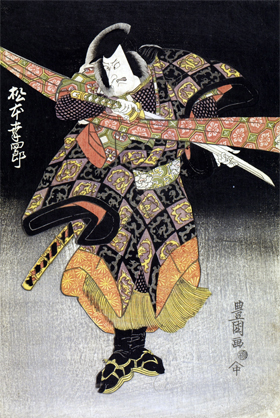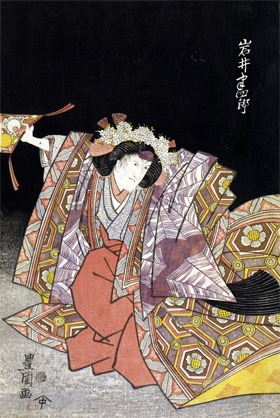| MODORIBASHI SENA-NI GOHIIKI |
| Play titles | Modoribashi Sena-ni Gohiiki Kabuki no Haru Futaba Manzai Ky˘ran Hidari Kikimasu Oyakozure Eda no Uguisu Modoribashi Mata no Kaomise |
|||||||||||||||||||||||||
| Author | Tsuruya Nanboku IV [1] | |||||||||||||||||||||||||
| History |
Tsuruya Nanboku IV's kaomise drama "Modoribashi Sena-ni Gohiiki" was premiered in the 11th lunar month of 1813 at the Ichimuraza [more details]. It included a Nagauta-based shosagoto entitled "Kabuki no Haru Futaba Manzai", another Nagauta-based shosagoto entitled "Ky˘ran Hidari Kikimasu" and a Tokiwazu/Gidayű-based shosagoto entitled "Oyakozure Eda no Uguisu". The opening day was the 13th day of the 11th lunar month of the 10th year of the Bunka era, which was the 5th of December 1813 in the western calendar. At the same time, Tsuruya Nanboku IV was also tatesakusha at the Moritaza, where his kaomise drama "Gohiiki Tsunagi Uma" was also premiered [more details]. The 29th day of the 11th lunar month [2], a fire broke out in Edo in the district of Takasago-ch˘ and destroyed both the Ichimuraza and the Nakamuraza. The troupe at the Ichimuraza went to the Moritaza and both troupes performed in a new kaomise drama entitled "Modoribashi Mata no Kaomise", which mixed acts from "Gohiiki Tsunagi Uma" and from "Modoribashi Sena-ni Gohiiki". "Modoribashi Sena-ni Gohiiki" fell into oblivion and was revived in January 1980 at the National Theatre [more details]. It included the shosagoto "Oyakozure Eda no Uguisu" in its third act. |
|||||||||||||||||||||||||
| Structure |
The original drama "Modoribashi Sena-ni Gohiiki" was in 11 acts. The 1980 revival was in 3 acts (4 scenes):
|
|||||||||||||||||||||||||
| Key words |
Ashigarayama Fujiwara Michikane Fujiwara Sumitomo Genji Hakone Heian Jidai Higekuro Hirai Yasumasa Jidaimono Jijo Kaid˘maru Kaomise Kazan Tenn˘ Kumo Kumo no Sei Kumo Taiji Kumo Yoten Minamoto Mitsunaka Minamoto Nakamitsu Minamoto Raik˘ Minamoto Yorimitsu Minamoto Yorinobu Modoribashi Nagauta Nyűd˘ Raik˘ Sadaish˘ Sakata Kintoki Sansh˘ Sanzoku Settsu Shitenn˘ Shitenn˘mono Shuten D˘ji S˘ma Yoshikado Tabako-uri Tada Mitsunaka Taira Masakado Taira Masamori Taira Yoshikado Tokiwazu Tsuchi-gumo Urabe Suetake Usui Sadamitsu Watanabe Tsuna Yamanba Yamanbamono Yamato Katsuragisan |
|||||||||||||||||||||||||
| Summary |
Act I, scene 1: Higekuro Sansh˘ It is the mid-Heian period and the government has fallen into the hands of a lax and corrupt aristocracy. In the east, Taira no Masakado has raised a rebellion against the Emperor, while the streets of Ky˘to in the west teem with thieves and robbers. All signs indicate a decline in the power and prestige of the imperial house. Amidst this chaos, the sadaish˘ Higekuro [5] stirs further confusion by making his own bid for imperial power. More commonly known as Shuten D˘ji, he has established his own court at his mountain palace, where he plots in secret and safety, joined by Iyo no Arinobu, the nyűd˘ Inokuma Raiun, and others. One of Higekuro's henchmen, the malevolent Tsukishima Nagatsura, brings Tada no Manjű, father of the Genji clan general Minamoto no Yorimitsu (commonly called Minamoto no Raik˘), to the mountain palace, accompanied by his son Minamoto no Yorinobu and Sekiya, sister of Minamoto no Nakamitsu. As the Genji clan grows in strength, Higekuro seeks to make them his allies, but Manjű and the others vehemently refuse his overtures. Higekuro's demeanor turns vicious, especially upon discovering that Yorinobu is the lover of Tsuru-no-Mae, the daughter of an aristocrat whom Higekuro intends to marry. Infuriated, he calls for a large knife and chopping block, ordering the heads of the three unyielding prisoners to be severed. Meanwhile, he commands a feast to take place, intending to enjoy himself while the execution unfolds. At that moment, a loud voice rings out from the gate, calling 'Shibaraku!' (Wait!), first once, then twice, then three times. To Higekuro's dismay, Raik˘'s loyal right-hand man, the valiant Usui no Sadamitsu, strides in. Higekuro's men cluster nervously, shuffling and jostling each other in a futile attempt to intimidate Sadamitsu into leaving, first with threats, then with coaxing. After a series of humorous exchanges, Sadamitsu confronts Higekuro, who reasserts his determination to usurp the Emperor's power. Though shortly taken aback by this show of strength, Sadamitsu regains his composure and suddenly seizes the jewel that symbolizes the Emperor's status, which Higekuro has hidden on himself. In a triumphant exit, Sadamitsu escorts the others to safety. Act I, scene 2: Kazan Furugosho Deep in the mountains lies a palace, the old palace of the retired Emperor Kazan, now in ruins and surrounded by dense forests. It serves as the lair of a spider spirit, which has fled from Mount Katsuragi after being attacked by a hero of the Genji clan, who captured its precious sword, Kumokirimaru [3]. A band of mountain robbers appears, carrying a case containing Buddhist scriptures, around which a small spider has spun its web. Suddenly, the case starts to move, causing the robbers to take fright and flee. From inside emerges the arch-thief Hakamadare no Yasusuke, brandishing Kumokirimaru, which he has stolen from Raik˘. The spider spirit arrives with reinforcements, leading to a fierce battle. Amidst the chaos, one of the men tries to escape with the sword, but he is halted by a new arrival: S˘ma Tar˘ Yoshikado, son of Masakado, whose rebellion in the east was quelled by the Emperor. Yoshikado has his own ambitions to overthrow the Emperor, and he jeers at the spider spirit and Yasusuke, claiming the sword for himself. Act II, scene 1: Settsu-no-Suke Raik˘ Yakata Raik˘, the commander-in-chief, suffers from illness, prompting Higekuro to send Takakuni-gimi [6] and Inokuma Raiun to visit him under the pretense of inquiring about his health. However, Raik˘'s wife, Sonoo-no-Mae, refuses to let them see him. Frustrated, Takakuni-gimi storms off. A tabako-uri named Sakamushi Oyoshi appears, seeming reluctant to share details about herself but cheerfully advertising her wares. When she learns from Sonoo-no-Mae about a military edict ordering the capture of all traitors, she quickly vanishes into the mansion. Moments later, a man named Mita Genta Hirotsuna arrives, claiming to be a messenger from Raik˘'s father. He says he has come to verify a rumor about the whereabouts of the sword Kumokirimaru. Neither Raik˘'s wife nor the retainer, ďya Tar˘ Mitsut˘, recognize him. Just then, Oyoshi reappears, having managed to steal the military edict. It becomes clear that she and the so-called messenger are acquainted. As she reveals the edict, a wild goose suddenly swoops down and snatches it away. Oyoshi chases after it, but no sooner has she disappeared than a cry rings out-she is stabbed with a dirk. Another man, who also claims to be Mita Genta Hirotsuna, appears. He has captured the wild goose and holds the military edict. He insists he, too, is a messenger from Raik˘'s father in search of Kumokirimaru [4]. Spiders have spun their webs around his sword. Inokuma Raiun returns with a sake pot, while the second messenger attempts to kill the spiders (kumo yoten) but suddenly breaks into a wild dance with the sake pot. When he regains his composure, the two messengers start fighting, but a woman named Oiwa appears out of nowhere and intervenes. The two men realize that they have each taken the other's sword. In truth, the men are Hakamadare no Yasusuke and S˘ma Tar˘ Yoshikado, while Oiwa is the spider spirit pursuing Kumokirimaru. She casts a spell, snatches the sword, and vanishes. Act III, scene 1: Hakone Ashigarayama Deep in the mountain of Ashigara, in a lonely wooden house, a mountain woman raises her son, Kaid˘maru. Two woodcutters appear. Onoemon from the east and Tetsuz˘ from the west. The child, who spends most of his time playing with boars and monkeys, eagerly asks the men to show him sum˘ wrestling. After their demonstration, Onoemon reveals his true purpose. He is, in fact, the Genji warrior Mita no Tsug˘, and he wants to uncover the identities of the mother and child. Astonished, the mountain woman explains that she was the wife of the palace guard, Sakata no Tokitsura, a man of weak disposition. Before his death, he had instructed her to raise their son to be a hero. In accordance with his wishes, they have lived in the mountains for the past seven years, protected by the mountain gods. Impressed by the boy's superhuman strength, Onoemon begs her to allow him to become a Genji warrior and personal guard to Raik˘. The other woodcutter, also a Genji soldier, encourages her to agree. The woman consents, saying she could not wish for more. With her mission fulfilled and nothing left to do, she disappears into the mountains. Minamoto no Yorimitsu and his followers arrive, and the boy, taking on the name Sakata Kintoki, bids an eternal farewell to his mother. |
|||||||||||||||||||||||||
| Notes |
[1] The others sakusha were Matsui K˘z˘ I, Katsu Hy˘suke, Sakurada Jisuke II, Tsuchii Hy˘shichi I, Matsushima Y˘suke II, Shinoda Kinji I, Katsuura Shűz˘, K˘rai Zensuke and Takamatsu Kisanji. [2] The 29th day of the 11th lunar lunar month of the 10th year of the Bunka era was the 21st of December 1813 in the western calendar. [3] Literally the Spider-Cutting Sword. [4] The roles of Oyoshi and Mita Genta Hirotsuna were both played by the same actor in January 1980 at the National Theatre. Onoe Sh˘roku II did it through a quick costume change (hayagawari). [5] Real name: Fujiwara Michikane. |
|||||||||||||||||||||||||
 |
 |
|
The actors Matsumoto K˘shir˘ V and Iwai Hanshir˘ V playing the roles of Minoda Genta Hirotsugu (in reality Hakamadare no Yasusuke) and Masakado's daughter Princess Nanaaya in the drama "Modoribashi Sena-ni Gohiiki", which was staged in the 11th lunar month of 1813 at the Ichimuraza (print made by Utagawa Toyokuni I) |
|
|
|
| Contact | Main | Top | Updates | Actors | Plays | Playwrights | Programs | Links | FAQ | Glossary | Chronology | Illustrations | Prints | Characters | Derivatives | Theaters | Coming soon | News |